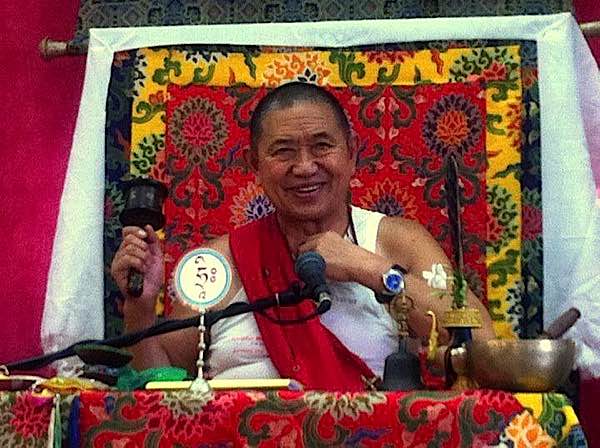9 Benefits of Buddhist Mantras: A Complete Buddhist Practice for Busy Lives, the Power of Intention, Accumulation, Sound and Dharma
Why are Mantras important in Mahayana and Vajrayana practice, especially in modern, busy times? What are the nine benefits of mantra as taught by Buddha and lineage teachers? How do mantras actually work? What is transmission from Sutra or lineage? Why and how do we accumulate mantras in our lifetime?
We answer these questions and more in this in-depth how-to feature on the benefits and practice of reciting or meditating with mantras.

Why Mantra is the Enlightened Speech of the Buddhas
In Buddhism, a mantra represents the essence of the Enlightened Speech of the Buddha. The teachings say that the mantra is not separate from the Deity.
Each time we praise or prostrate to our Yidam or Buddha, we are honoring the Enlightened Body, Speech and Mind. To support our practice, we often display a statue or picture representing the Enlightened Body, and we may display either a Stupa or Bell to represent the Enlightened Mind. The most important of the three, the Enlightened Speech, representing Dharma, is supported by Mantras.
As Mahayana Buddhists we aspire to achieve the Enlightened Body, Speech and Mind for the benefit of all sentient beings. Until we attain Enlightenment, our tangible supports are usually a statue or visualization of the Buddha’s body in the form of the Yidam we aspire to, the bell for Mind and our Mala to represent the Speech and Mantras.

Of the three, the most important support in busy times, when we have no time for extensive practice, is our Mantras. Dharma and speech are the most important elements of Buddhist practice. The Enlightened Body of the Buddhas have gone beyond Samsara, and the mind or teachings are now preserved as Dharma and Dharma Speech. This is why we strive to preserve and spread the Dharma.
Dharma Teachings as Mantra
This concept is grounded in the Buddha Dharma, which holds that enlightened beings, or Buddhas, have achieved a profound understanding of reality and communicate this wisdom through mantras (Harvey, 2013).

The vibration produced by reciting a mantra can profoundly affect the practitioner’s state of mind, promoting focus and calm. It is this power of sound vibration that is central to the mantra practice. Renowned Buddhist teacher, Pema Chodron explains,
“When you say your mantra, as with all practices, you have to bring your full attention… You become the words… It’s like eating, you don’t just swallow without chewing; You chew and savour every word of your mantra” (Chodron, 2001).

From a scientific perspective, mantra recitation and the associated sound vibration have been shown to change the waveforms emitted by the brain, leading to increased concentration and mental clarity (Lutz et al., 2004). (This study is here>>) This physiological response can crucially support individuals in our fast-paced modern society, where distractions and stressors are abundant – a clear justification for mantra practice in these busy times.
As Buddhists, the goal is not just to mindlessly recite mantras, but to thoroughly understand the profound meaning and conduct intention setting with every recitation.
It can be beneficial to receive transmission from the Sutra or lineage teachers who have been trained in the proper pronunciation and rhythmic recitation of the mantras in Sanskrit – the language in which they were originally composed. This is thought to maximize the power of the mantras (Cüppers, 2012). (More on transmission in section below.)
Sutra-transmitted Dharani and mantra of Amitabha:
However, for any Sutra-transmitted mantras or Dharanis, no transmission is needed for benefits. The transmission and the accompanying teaching is already made from Buddha to Sutra to you through the Holy Dharma teachings.
Another Sutra transmitted mantra and Dharani, of Avalokiteshvara, Bodhisattva of Compassion:
What is Mantra? Protection for the Mind? Essence of Dharma?
Mantra literally translates from Sanskrit as “Mind Protection.” What does this mean? Lama Zopa Rinpoche explained Nyungna Teachings at Lawudo:
“The meaning of mantra is “guarding the mind.” Guarding it from what? From clinging, or attachment, and the view of this life.
“It means guarding the mind from attachment, the view of this life, and the three lower realms. It means guarding the mind from the whole suffering realm of samsara, which means all six realms, and from seeking and being bound to the blissful state of peace for self. It guards the mind, or in other words, it guards oneself. It means the same thing. It is related to guarding the mind but it means guarding you from all these problems and from binding yourself to the blissful state of peace. It also guards your mind from the impression of the subtle dualistic view.”

Mantra is also an essence practice. When you chant Om at the beginning of most mantras, this is paying homage to, taking refuge in, and invoking the Enlightened Body, Speech, and Mind of the Buddha in whatever form you visualize as your Yidam or meditational deity.
This is why when teachers hear their students say: “I have no time to practice” they often reply:
“You have time to say a mantra don’t you?”
Vajrasattva mantra is one of the first mantras taught to serious Buddhist students in Vajrayana:
This means, the mantra itself is a complete and essential practice, especially for busy people. This is why mantra is the most effective practice for modern people leading busy, stressful lives. It’s not a magic spell. It’s a focus for the mind. As soon as we say the mantra “Om Mani Padme Hum” we are invoking the Body Speech and Mind of the Compassionate Lotus Avalokiteshvara Guanyin Chenrezig.
In fact, in Kyabje Garchen Rinpoche’s explanation of the nine benefits of mantra, which we’ll cover in a moment, the first benefit stated was “Mantra can be understood as the Deity.”

Nine Benefits of Mantra According to the Teachings
According to Garchen Rinpoche, in his superb book Vajrakilaya: A Complete Guide with Experiential Instructions [1] the great teacher mapped out the nine benefits of Buddhist Mantra of Enlightened Deities, especially when combined with the visualizations:
Mantra can be understood as The deity. Every mantra we recite emanates one deity. These deities then work for the benefit of beings.
Mantra can be understood as Offerings to the Buddha.
Mantra can be understood as Purification of Obstacles.
Mantra can be understood as Siddhis, in the form of Blessings.
Mantra brings about loving-kindness and compassion in the practitioner.
Mantra, when one has fully trained in the creation stage, invokes the entire mandala. One no longer needs an entire sadhana text.
Mantra brings about all of the four activities — peaceful, increasing, powerful and wrathful.
Mantra is a wish-fulfilling jewel.
Mantra cuts conceptual thought because it is sound-emptiness. Other sounds produce the graspings of attachment and aversion.

Mantra Repetition and Accumulation
Almost by definition mantra is meant to be recited and repeated. Contrary to mantra myth, mantras do not have to be tonelessly spoken. They can certainly be chanted. If music and chanting make the repetition of the mantra easier, this actually increases its effectiveness. Chanting is often used in formal teachings to inspire long sessions of repetition. For this reason, our practice supports for mantra are Malas for counting and Prayer Wheels for added accumulations.

Devotional chants and prayers are commonly sung in many temples, together with mantras. Sutras are often chanted musically, as well, such as the precious Heart Sutra, which is musically chanted around the world. Chanting with drums is also helpful. Many Tibtean teachers, including Garchen Rinpoche encourage chanting or musical mantras. Om Mani Padme Hum is usually chanted musically in most group sessions, for example.
Video: Chanting 100,000 Mani Mantras for World Peace is virtuous for everyone. The accumulations of your mantras, especially as a accumulation mantra group, benefits many sentient beings.
What about Accumulation? When a teacher or Sutra or Tantra advises accumulations of Vajrasattva’s mantra for purification, or Om Mani Padme Hum for World Peace, what does this really mean?
Accumulations of mantras are common Yidam practices, especially in what is often called the Mantra Counting Retreat. We are asked, for example, to accomplish 100,000 mantras using our malas to count. Each mala is 108 mantras, but counted as 100 due to “mistakes.”
Yidam and Mantra
The concept of accumulation is to focus the mind on the Body, Speech, and Mind of the Buddha, or our chosen meditational form of the Buddha, known as the Yidam. During informal retreats, these are accumulated over time, not all in one session, necessarily, which would be impossible for most modern lay people. As long we chant some every day, after having taken Refuge in the Buddha, the Dharma, and the Sangha, and as long as we dedicate our mantra practice at the end of each session, then this is considered accumulative. 30 today, 100 tomorrow, 20 the day after, 50 the day after, and 800 on the weekend — as long as we’ve dedicated the merit to the benefit of all sentient beings, this is an accumulation of 1,000. We continue daily until we reach 100,000.
Video: Accumulating 100,000 mantras of a Higher Yoga Tantra Buddha like Hayagriva would normally only be understaken by a serious student, guided by a teacher. The mantra can be beneficial to chant for “even the insects” according to the Origination Sutra, but a retreat on a Deity is normally a serious commitment:
What happens then? We keep going, but if we’re doing a formal retreat, our teacher will advise us to seal or dedicate the accumulated merit and purify any mistakes we’ve made with either a Fire Puja or with another purification practice such as Vajrasattva.
Once we accomplish this, the merit is fully accumulated. This bonds us forever to the Enlightened Body, Speech and Mind of the Buddha, in the form of Yidam we practice. This might be Tara, or Vajrasattva, or Vajrakilaya, or Hayagriva, or Medicine Buddha — whichever mantra we’ve have practiced.
Transmission is Beneficial, Not Usually Required
A lot of mythology has arisen around the concepts of permissions and mantras. With the proviso that we should be guided by our own teachers on this, the main requirement for mantra chanting of any Enlightened Deity according to the teachings, is Bodhichitta intention. This, in concise terms, is the intention to become Enlightened for the benefit of all sentient beings.
One of the eloquent teachers on this topic is Kyabje Garchen Rinpoche. For a recent retreat, he published this on the Garchen Institute website:
“There are no restrictions. Why? For the Buddha, there was no difference between nationality or religions because all sentient beings are really Buddhas; they are only obscured by temporary stains. When these temporary stains are removed then beings are actual Buddhas. It just depends on whether or not we have fixating thoughts in our mind.
Lord Jigten Sumgon had said that whoever grasps at any philosophical school is an ordinary person. Actually, any philosophical school is just illusory because whoever has a mind has the Buddha within them. Therefore all sentient beings possess the cause of awakening and if they want to become a Buddha, they can. For this reason, whatever is online or on livestream, is not restricted. Anybody can take whatever they want and look at whatever they want and for however long they want. I encourage you to do this. This is the Buddha’s instruction.”
In fact, the “temporary stains” His Eminence referred to are one of the reasons we chant mantras. By staying focused on the precious Enlightened Speech of the Buddhas, we help to remove our obstacles, negativities and stains.
The Vajra Guru mantra of Guru Rinpoche Padmasambhava have countless benefits. If you have time for only one mantra, this one is the same as practicing all five Buddha Families:
Sources and Citations
[1] Vajrakilaya: A Complete Guide with Experiential Instructions, Kyabje Garchen Rinpoche (https://amzn.to/48V9svg affiliate link to this book on Amazon)
Harvey, P. (2013). An introduction to Buddhism: Teachings, history and practices. Cambridge University Press.
Chodron, P. (2001). The wisdom of no escape and the path of loving-kindness. Shambhala Publications.
Lutz, A., Greischar, L. L., Rawlings, N. B., Ricard, M., & Davidson, R. J. (2004). Long-term meditators self-induce high-amplitude gamma synchrony during mental practice. Proceedings of the National Academy of Sciences, 101(46), 16369-16373.
Dalai Lama. (2006). The universe in a single atom: The convergence of science and spirituality. Harmony Books.
Cüppers, CH. (2012). The sound of the Dalai Lama’s voice: an ethnomusicology of Tibetan Buddhist chant. PhD thesis. Royal Holloway University.
More articles by this author
Search
Latest Features
Please support the "Spread the Dharma" mission as one of our heroic Dharma Supporting Members, or with a one-time donation.
Please Help Support the “Spread the Dharma” Mission!

Be a part of the noble mission as a supporting member or a patron, or a volunteer contributor of content.
The power of Dharma to help sentient beings, in part, lies in ensuring access to Buddha’s precious Dharma — the mission of Buddha Weekly. We can’t do it without you!
A non-profit association since 2007, Buddha Weekly published many feature articles, videos, and, podcasts. Please consider supporting the mission to preserve and “Spread the Dharma." Your support as either a patron or a supporting member helps defray the high costs of producing quality Dharma content. Thank you! Learn more here, or become one of our super karma heroes on Patreon.
Lee Kane
Author | Buddha Weekly
Lee Kane is the editor of Buddha Weekly, since 2007. His main focuses as a writer are mindfulness techniques, meditation, Dharma and Sutra commentaries, Buddhist practices, international perspectives and traditions, Vajrayana, Mahayana, Zen. He also covers various events.
Lee also contributes as a writer to various other online magazines and blogs.


















